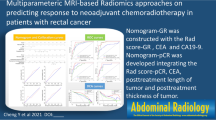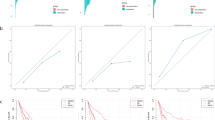Abstract
Objectives
To develop and validate a radiomics predictive model based on pre-treatment multiparameter magnetic resonance imaging (MRI) features and clinical features to predict a pathological complete response (pCR) in patients with locally advanced rectal cancer (LARC) after receiving neoadjuvant chemoradiotherapy (CRT).
Methods
One hundred and eighty-six consecutive patients with LARC (training dataset, n = 131; validation dataset, n = 55) were enrolled in our retrospective study. A total of 1,188 imaging features were extracted from pre-CRT T2-weighted (T2-w), contrast-enhanced T1-weighted (cT1-w) and ADC images for each patient. Three steps including least absolute shrinkage and selection operator (LASSO) regression were performed to select key features and build a radiomics signature. Combining clinical risk factors, a radiomics nomogram was constructed. The predictive performance was evaluated by receiver operator characteristic (ROC) curve analysis, and then assessed with respect to its calibration, discrimination and clinical usefulness.
Results
Thirty-one of 186 patients (16.7%) achieved pCR. The radiomics signature derived from joint T2-w, ADC, and cT1-w images, comprising 12 selected features, was significantly associated with pCR status and showed better predictive performance than signatures derived from either of them alone in both datasets. The radiomics nomogram, incorporating the radiomics signature and MR-reported T-stages, also showed good discrimination, with areas under the ROC curves (AUCs) of 0.948 (95% CI, 0.907-0.989) and 0.966 (95% CI, 0.924-1.000), as well as good calibration in both datasets. Decision curve analysis confirmed its clinical usefulness.
Conclusions
This study demonstrated that the pre-treatment radiomics nomogram can predict pCR in patients with LARC and potentially guide treatments to select patients for a “wait-and-see” policy.
Key Points
• Radiomics analysis of pre-CRT multiparameter MR images could predict pCR in patients with LARC.
• Proposed radiomics signature from joint T2-w, ADC and cT1-w images showed better predictive performance than individual signatures.
• Most of the clinical characteristics were unable to predict pCR.






Similar content being viewed by others
Abbreviations
- CA199:
-
Carbohydrate antigen-199
- CEA:
-
Carcinoembryonic antigen
- CRT:
-
Chemoradiotherapy
- DCA:
-
Decision curve analysis
- GLCM:
-
Grey-level co-occurrence matrix
- GLRLM:
-
Grey-level run length matrix
- GLSZM:
-
Grey-level size zone matrix
- LARC:
-
Locally advanced rectal cancer
- LASSO:
-
Least absolute shrinkage and selection operator
- pCR:
-
Pathological complete response
- TME:
-
Total mesorectal excision
- TRG:
-
Tumour response grading
References
van Gijn W, Marijnen CA, Nagtegaal ID et al (2011) Preoperative radiotherapy combined with total mesorectal excision for resectable rectal cancer: 12-year follow-up of the multicentre, randomised controlled TME trial. Lancet Oncol 12:575–582
Kapiteijn E, Marijnen CA, Nagtegaal ID et al (2001) Preoperative radiotherapy combined with total mesorectal excision for resectable rectal cancer. N Engl J Med 345:638–646
Maas M, Nelemans PJ, Valentini V et al (2010) Long-term outcome in patients with a pathological complete response after chemoradiation for rectal cancer: a pooled analysis of individual patient data. Lancet Oncol 11:835–844
Habr-Gama A, Perez RO, Proscurshim I et al (2006) Patterns of failure and survival for nonoperative treatment of stage c0 distal rectal cancer following neoadjuvant chemoradiation therapy. J Gastrointest Surg 10:1319–1328 discussion 1328-1329
Maas M, Beets-Tan RG, Lambregts DM et al (2011) Wait-and-see policy for clinical complete responders after chemoradiation for rectal cancer. J Clin Oncol 29:4633–4640
Renehan AG, Malcomson L, Emsley R et al (2016) Watch-and-wait approach versus surgical resection after chemoradiotherapy for patients with rectal cancer (the OnCoRe project): a propensity-score matched cohort analysis. Lancet Oncol 17:174–183
van Stiphout RG, Valentini V, Buijsen J et al (2014) Nomogram predicting response after chemoradiotherapy in rectal cancer using sequential PETCT imaging: a multicentric prospective study with external validation. Radiother Oncol 113:215–222
Goh V, Padhani AR, Rasheed S (2007) Functional imaging of colorectal cancer angiogenesis. Lancet Oncol 8:245–255
Gollub MJ, Tong T, Weiser M et al (2017) Limited accuracy of DCE-MRI in identification of pathological complete responders after chemoradiotherapy treatment for rectal cancer. Eur Radiol 27:1605–1612
Sun YS, Zhang XP, Tang L et al (2010) Locally advanced rectal carcinoma treated with preoperative chemotherapy and radiation therapy: preliminary analysis of diffusion-weighted MR imaging for early detection of tumor histopathologic downstaging. Radiology 254:170–178
Nougaret S, Vargas HA, Lakhman Y et al (2016) Intravoxel incoherent motion-derived histogram metrics for assessment of response after combined chemotherapy and radiation therapy in rectal cancer: initial experience and comparison between single-section and volumetric analyses. Radiology 280:446–454
Yu J, Xu Q, Song JC et al (2017) The value of diffusion kurtosis magnetic resonance imaging for assessing treatment response of neoadjuvant chemoradiotherapy in locally advanced rectal cancer. Eur Radiol 27:1848–1857
Zhang C, Tong J, Sun X et al (2012) 18F-FDG-PET evaluation of treatment response to neo-adjuvant therapy in patients with locally advanced rectal cancer: a meta-analysis. Int J Cancer 131:2604–2611
Curvo-Semedo L, Lambregts DM, Maas M et al (2011) Rectal cancer: assessment of complete response to preoperative combined radiation therapy with chemotherapy—conventional MR volumetry versus diffusion-weighted MR imaging. Radiology 260:734–743
Gillies RJ, Kinahan PE, Hricak H (2016) Radiomics: images are more than pictures, they are data. Radiology 278:563–577
Kiessling F (2018) The changing face of cancer diagnosis: from computational image analysis to systems biology. Eur Radiol 28:3160–3164
Huang Y, Liu Z, He L et al (2016) Radiomics signature: a potential biomarker for the prediction of disease-free survival in early-stage (I or II) non-small cell lung cancer. Radiology 281:947–957
Kickingereder P, Gotz M, Muschelli J et al (2016) Large-scale radiomic profiling of recurrent glioblastoma identifies an imaging predictor for stratifying anti-angiogenic treatment response. Clin Cancer Res 22:5765–5771
Zhang B, Tian J, Dong D et al (2017) Radiomics features of multiparametric MRI as novel prognostic factors in advanced nasopharyngeal carcinoma. Clin Cancer Res 23:4259–4269
Kim JH, Ko ES, Lim Y et al (2017) Breast cancer heterogeneity: MR imaging texture analysis and survival outcomes. Radiology 282:665–675
Huang YQ, Liang CH, He L et al (2016) Development and validation of a radiomics nomogram for preoperative prediction of lymph node metastasis in colorectal cancer. J Clin Onco 34:2157–2164
Nie K, Shi L, Chen Q et al (2016) Rectal cancer: assessment of neoadjuvant chemoradiation outcome based on radiomics of multiparametric MRI. Clin Cancer Res 22:5256–5264
De Cecco CN, Ganeshan B, Ciolina M et al (2015) Texture analysis as imaging biomarker of tumoral response to neoadjuvant chemoradiotherapy in rectal cancer patients studied with 3-T magnetic resonance. Invest Radiol 50:239–245
Liu Z, Zhang XY, Shi YJ et al (2017) Radiomics analysis for evaluation of pathological complete response to neoadjuvant chemoradiotherapy in locally advanced rectal cancer. Clin Cancer Res 23:7253–7262
Edge SB, Compton CC (2010) The American Joint Committee on Cancer: the 7th edition of the AJCC cancer staging manual and the future of TNM. Ann Surg Oncol 17:1471–1474
Mandard AM, Dalibard F, Mandard JC et al (1994) Pathologic assessment of tumor regression after preoperative chemoradiotherapy of esophageal carcinoma. Clinicopathologic correlations. Cancer 73:2680–2686
Chalkidou A, O'Doherty MJ, Marsden PK (2015) False discovery rates in PET and CT studies with texture features: a systematic review. PLoS One 10:e0124165
Sauerbrei W, Royston P, Binder H (2007) Selection of important variables and determination of functional form for continuous predictors in multivariable model building. Stat Med 26:5512–5528
Kramer AA, Zimmerman JE (2007) Assessing the calibration of mortality benchmarks in critical care: The Hosmer-Lemeshow test revisited. Crit Care Med 35:2052–2056
Wu S, Zheng J, Li Y et al (2017) A radiomics nomogram for the preoperative prediction of lymph node metastasis in bladder cancer. Clin Cancer Res 23:6904–6911
Jacobs L, Intven M, van Lelyveld N et al (2016) Diffusion-weighted MRI for early prediction of treatment response on preoperative chemoradiotherapy for patients with locally advanced rectal cancer: a feasibility study. Ann Surg 263:522–528
Elmi A, Hedgire SS, Covarrubias D et al (2013) Apparent diffusion coefficient as a non-invasive predictor of treatment response and recurrence in locally advanced rectal cancer. Clin Radiol 68:e524–e531
Tong T, Sun Y, Gollub MJ et al (2015) Dynamic contrast-enhanced MRI: use in predicting pathological complete response to neoadjuvant chemoradiation in locally advanced rectal cancer. J Magn Reson Imaging 42:673–680
Martens MH, Subhani S, Heijnen LA et al (2015) Can perfusion MRI predict response to preoperative treatment in rectal cancer? Radiother Oncol 114:218–223
Intven M, Reerink O, Philippens ME (2015) Dynamic contrast enhanced MR imaging for rectal cancer response assessment after neo-adjuvant chemoradiation. J Magn Reson Imaging 41:1646–1653
Blazic IM, Lilic GB, Gajic MM (2017) Quantitative assessment of rectal cancer response to neoadjuvant combined chemotherapy and radiation therapy: comparison of three methods of positioning region of interest for ADC measurements at diffusion-weighted MR imaging. Radiology 282:418–428
Choi MH, Oh SN, Rha SE et al (2016) Diffusion-weighted imaging: apparent diffusion coefficient histogram analysis for detecting pathologic complete response to chemoradiotherapy in locally advanced rectal cancer. J Magn Reson Imaging 44:212–220
Bundschuh RA, Dinges J, Neumann L et al (2014) Textural parameters of tumor heterogeneity in 18F-FDG PET/CT for therapy response assessment and prognosis in patients with locally advanced rectal cancer. J Nucl Med 55:891–897
Ng F, Ganeshan B, Kozarski R et al (2013) Assessment of primary colorectal cancer heterogeneity by using whole-tumor texture analysis: contrast-enhanced CT texture as a biomarker of 5-year survival. Radiology 266:177–184
Jwa E, Kim JH, Han S et al (2014) Nomogram to predict ypN status after chemoradiation in patients with locally advanced rectal cancer. Br J Cancer 111:249–254
Funding
This work was supported by the fund of Science and Technology Project of Shanxi Province (No. 20150313007-5).
Author information
Authors and Affiliations
Corresponding author
Ethics declarations
Guarantor
The scientific guarantor of this publication is Xiaotang Yang.
Conflict of interest
The authors of this manuscript declare no relationships with any companies, whose products or services may be related to the subject matter of the article.
Statistics and biometry
No complex statistical methods were necessary for this paper.
Informed consent
Written informed consent was waived by the institutional review board.
Ethical approval
Institutional review board approval was obtained.
Methodology
• retrospective
• diagnostic or prognostic study
• performed at one institution
Rights and permissions
About this article
Cite this article
Cui, Y., Yang, X., Shi, Z. et al. Radiomics analysis of multiparametric MRI for prediction of pathological complete response to neoadjuvant chemoradiotherapy in locally advanced rectal cancer. Eur Radiol 29, 1211–1220 (2019). https://doi.org/10.1007/s00330-018-5683-9
Received:
Revised:
Accepted:
Published:
Issue Date:
DOI: https://doi.org/10.1007/s00330-018-5683-9




